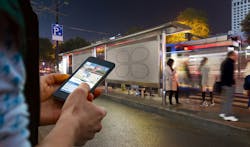Wi-Fi-Enabled Buses Can Serve as the Foundation for Building a Smart City
When Maryland state and county officials recently cut the ribbon on a new bus route, they made sure to highlight the fact that each bus offers a Wi-Fi connection. It’s the latest example of the nationwide push to equip buses and other mass transit systems with Wi-Fi. But the potential exists to offer riders so much more than a mobile Wi-Fi hotspot for checking emails or watching Netflix. Imagine the benefits of integrating the entire fleet into a city-wide network that provides riders with real-time information, news updates and offers from local businesses, government agencies and the mass transit system based on their locations. That doesn’t have to be a dream for the future. The technology exists today that will compel more people to ride buses, and even enable municipal officials to move forward with their plans to build smart cities.
Adding high speed wireless Internet access to buses is an important first step to achieving those goals, and their numbers are growing nationwide. According to the American Public Transit Association (APTA), the percentage of buses outfitted with Wi-Fi rose from just 0.5 percent in 2008 to 5.1 percent in 2014. But it appears that enabling people to get some work done or entertain themselves is not enough to make riding the bus a more compelling alternative to driving their own cars.
Last year, the research group TransitCenter asked more than 3,000 online respondents from 17 regions across the country what upgrades they’d like to see on their commutes. They provided several options including free Wi-Fi, power outlets, more frequent service, faster travel times, cheaper fares, robust shelters, and updates on when their buses will arrive. The outlets and Wi-Fi came in last place.
Of course people are more concerned about on-time schedules and convenient routes, that’s not a surprising finding. But that does not mean transit systems should slow efforts to connect buses to the Internet. Just the opposite, in fact.
Putting the “Smart” in Smart Cities
Nearly 80 percent of Americans carry smartphones. They’re connected to the web, and each other, every minute of the day. This creates tremendous opportunities to turn bus stops and buses into vehicles (pardon the pun) for delivering government services more efficiently, and for triggering many useful mobile applications depending on the user context such as the end user waiting at the bus stop for example. This is also the opportunity to engage businesses with their customers through targeted and highly personalized content.
The mass transit system can serve as the foundation for a so-called “smart city” that improves the overall quality of life for residents and spurs long-term economic growth. Turning train stations, bus stops, airports and even parking spaces and street lights, into a smart network creates a web of interactive points that enable residents and visitors to receive hyper-contextualized, proximity-based, relevant notifications on their mobile devices.
FR public transportation operator Keolis has installed near field communications (NFC) tags - the same wireless two-way communications standard you may use when you send files wirelessly to another person’s phone, or make a purchase at a store - to bus stops in the city of Bordeaux. These NFC tags can provide up-to-the-minute updates to travelers on bus arrival times. The rider simply taps his or her phone to the bus stop tag to see live information on the next buses due to arrive at the stop, and at bus stops nearby.
But the possibilities this next-generation internet communications network holds for cities extend far beyond helping people stay on schedule.
Scratching the Surface
Consider the benefits to businesses. Retailers can engage with their target customers while they’re waiting at bus stops or during their bus rides because they’ll know they’re on routes that will eventually take them near a specific store or restaurant.
Also, government agencies can send real-time alerts with relevant news and information about a broken water main on Main Street that includes up-to-date information on how it’s affecting traffic patterns, businesses, schools and homes in the area.
Deploying networks of contactless technology beacons based on open standards such as NFC, Bluetooth Low Energy (BLE) QR codes and Wi-Fi turns passive, urban assets into smart interaction points, which are able to initiate two-way communications with residents’ and visitors’ smartphones, tablets, smartwatches and other mobile devices. That may sound like science fiction, but cities across Europe and Asia are making that happen today.
In 2012, Officials in Eurométropole de Strasbourg created a massive network of sensors that constantly collects and disseminates information citywide. It launched the Connected City mobile service in France, creating a network of 1,400 city points of interest (i.e. tourist attractions and bus stops). Residents and visitors use their mobile devices to access real-time, hyper-contextualized information related to transport and nearby city points of interest.
No “Walled Gardens”
Notice that the communications technologies I listed above - NFC, Bluetooth, QR codes and Wi-Fi - are all open communications standards. In other words, manufacturers can ensure their products can “talk” to other devices, even those made by their competitors.
We’re in the early days of the development of the Internet of Things (IoT) age. As manufactures rush to build new connected devices, they tend to do so within “walled gardens” that make them incompatible with their competitors’ products. You may be familiar with this if you’ve tried to connect your phone or smart speaker to your Internet-enabled thermostat, light bulbs, or home entertainment systems. After all, you can only shout “Alexa!”, “OK Google!” or “Hey Siri!” so many times before you realize there’s a problem.
For that reason, municipal officials should insist on only partnering with technology developers and integrators that agree to leveraging universal communications and interoperability standards. That’s how you build a mass transit system that people want to use not just to check emails on the way to work, but so they can be more engaged with their communities.
And it all starts with connecting buses to with their travelers.
Laetitia Gazel Anthoine is the founder and CEO of Connecthings, a U.S.-European based technology and IoT enabling company. Connecthings implements contactless technologies into the public space to turn urban, passive physical assets into smart, connected objects.
About the Author

Laetitia Gazel Anthoine
founder and CEO
Laetitia Gazel Anthoine is the founder and CEO of Connecthings, a U.S.-European based technology and IoT enabling company. Connecthings implements contactless technologies into the public space to turn urban, passive physical assets into smart, connected objects.
